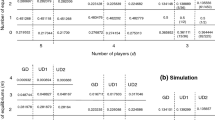Abstract
A one-step (birth–death) process is used to investigate stochastic noise in an elementary two-phenotype evolutionary game model based on a payoff matrix. In this model, we assume that the population size is finite but not fixed and that all individuals have, in addition to the frequency-dependent fitness given by the evolutionary game, the same background fitness that decreases linearly in the total population size. Although this assumption guarantees population extinction is a globally attracting absorbing barrier of the Markov process, sample trajectories do not illustrate this result even for relatively small carrying capacities. Instead, the observed persistent transient behavior can be analyzed using the steady-state statistics (i.e., mean and variance) of a stochastic model for intrinsic noise that assumes the population does not go extinct. It is shown that there is good agreement between the theory of these statistics and the simulation results. Furthermore, the ESS of the evolutionary game can be used to predict the mean steady state.
Similar content being viewed by others
References
Bharucha-Reid, A.T., 1960. Elements of the Theory of Markov Processes and Their Applications. McGraw-Hill, New York.
Broom, M., 2005. Evolutionary games with variable payoffs. Comp. Rendus Biol. 328, 403–412.
Cressman, R., 1992. The Stability Concept of Evolutionary Game Theory. Springer-Verlag, Heidelberg, New York.
Ficici, S., Pollack, J., 2000. Effects of finite populations on evolutionary stable strategy. In: Darrell Whitley, L. (Ed.), Proceedings of the 2000 Genetic and Evolutionary Computation Conference. Morgan-Kaufmann, San Francisco, pp. 927–934.
Fogel, G., Fogel, D., Andrews, P., 1997. On the instability of evolutionary stable strategies. Biosystems 44, 135–152.
Fogel, G., Andrews, P., Fogel, D., 1998. On the instability of evolutionary stable strategies in small populations. Ecol. Model. 109, 283–294.
Foster, D., Young, P., 1990. Stochastic evolutionary game dynamics. J. Theor. Biol. 38, 219–232.
Gillespie, D.T., 1977. Exact stochastic simulation of coupled chemical reactions. J. Phys. Chem. 25, 2340–2361.
Hastings, A., 2004. Transients: The key to long-term ecological understanding. TREE 19, 39–45.
Hofbauer, J., Sigmund, K., 1998. The Theory of Evolution and Dynamical Systems. Cambridge University Press, Cambridge.
Hofbauer, J., Sigmund, K., 2003. Evolutionary game dynamics. Bull. Am. Math. Soc. 40, 479–519.
Kandori, M., Mailath, G.J., Rob, R., 1993. Learning, mutation, and long-run equilibria in games. Econometrica 61, 29–56.
Lessard, S., 1984. Evolutionary dynamics in frequency-dependent two-phenotype models. Theor. Pop. Biol. 25, 210–234.
Maynard Smith, J., 1982. Evolution and the Theory of Games. Cambridge University Press, Cambridge.
Moran, P.A.P., 1962. The Statistical Processes of Evolutionary Theory. Clarendon Press, Oxford.
Nasell, I., 2001. Extinction and quasi-stationarity in the Verhulst logistic model. J. Theor. Biol. 211, 11–27.
Ohtsuki, H., Hauert, C., Lieberman, E., Nowak, M., 2006. A simple rule for the evolution of cooperation on graphs and social networks. Nature 441, 502–505.
Peck, J.R., Feldman, M.W., 1988. Kin selection and the evolution of monogamy. Science 240, 1672–1674.
Pielou, E.C., 1977. Mathematical Ecology. Wiley, New York.
Seneta, E., 1996. Quasi-stationary behaviour in the random walk with continuous time. Aust. J. Stat. 8, 92–98.
Swift, R.J., 2002. A stochastic predator–prey model. Irish Math. Soc. Bull. 48, 57–63.
Tao, Y., 2004. Intrinsic noise, gene regulation and steady-state statistics in a two-gene network. J. Theor. Biol. 231, 563–568.
Tao, Y., Jia, Y., Dewey, T.G., 2005. Stochastic fluctuations in gene expression for far from equilibrium: Omega expansion and linear noise approximation. J. Phys. Chem. 122, 124108.
Taylor, C., Fudenberg, D., Sasaki, A., Nowak, M.A., 2004. Evolutionary game dynamics in finite populations. Bull. Math. Biol. 66, 1621–1644.
Taylor, P.D., Jonker, L.B., 1978. Evolutionarily stable strategies and game dynamics. Math. Biosci. 40, 145–156.
Thattai, M., van Oudenaarden, A., 2001. Intrinsic noise in gene regulatory networks. Proc. Natl. Acad. Sci. U.S.A. 98, 8614–8619.
Van Kampen, N. G., 1992. Stochastic Process in Physics and Chemistry. North-Holland, Amsterdam.
Author information
Authors and Affiliations
Corresponding author
Rights and permissions
About this article
Cite this article
Tao, Y., Cressman, R. Stochastic Fluctuations Through Intrinsic Noise in Evolutionary Game Dynamics. Bull. Math. Biol. 69, 1377–1399 (2007). https://doi.org/10.1007/s11538-006-9170-0
Received:
Accepted:
Published:
Issue Date:
DOI: https://doi.org/10.1007/s11538-006-9170-0




